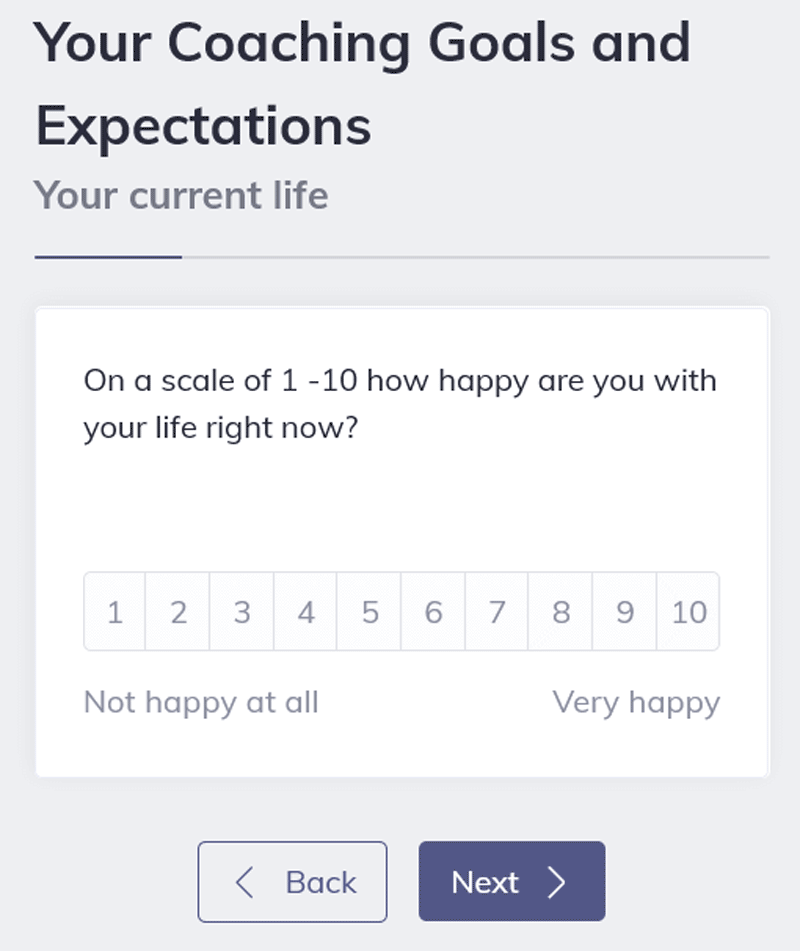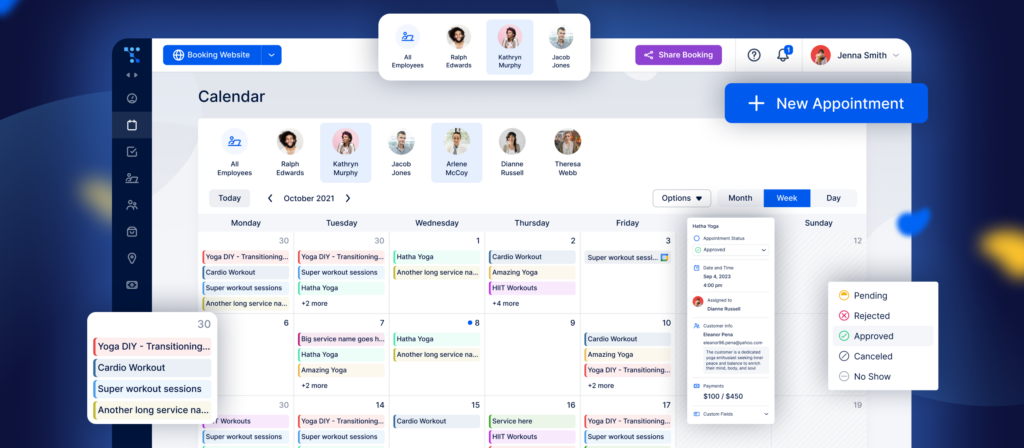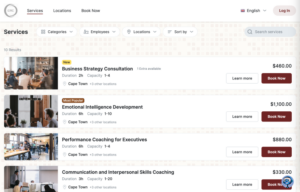If you want to run a coaching business, there are many things to consider. One important thing to consider is organization. This article will teach you how to use life coaching intake forms and show you examples.
You may be the best professional life coach but your business won’t prosper without proper organization. Implementing a system of coaching intake forms will help keep your files in order.
A life coaching intake form is an important tool in your coaching relationship. Here you can record and summarize everything that you and your client agreed on during your first meeting.
The onboarding process is an excellent chance to gather information from your client’s life story. This guide on intake forms will help you get a strong start on every coaching relationship.
What Is Life Coaching Intake Form?

A life coaching intake form is a tool used before the first session and after the client makes the first payment. This document will have important data about the client including basic details, personal goals, and expectations. They also indicate what types of services the client needs.
Your life coaching intake form creates a solid base to plan your strategy. It helps you build the right package for each coaching session.
For this to work, every new client should complete the form with as much detail as possible. The information may include name, address, profession, age, etc. Try to include the most relevant questions that will best help you determine what the person needs.
The Advantages of Creating a Life Coaching Intake Form
The intake session is more than a simple meeting. This is the ground on which you base your entire relationship with the client.
You have only one chance to make a first impression. Use it wisely. Take this time to build trust and earn respect while you get to know Your client. This approach helps you save time, prepare follow-up questions, and streamline your process.
The life coaching intake form takes all your client information and puts it in one place. You won’t lose any valuable data and it will be much easier to access at any time.
What do you need to know about your new clients? Here are the basics:
- Who they are. This includes both practical data and professional information. For example, you can ask about their expectations, interests, and strengths.
- Where they are. Find out what their situation is right now. After all, there’s a reason they are looking for a coaching business.
- Where they wish to be. Thanks to this information, you’ll be able to shape proper questions and help the clients find their way.
In summary, the questions on your life coaching intake form will provide clear insights and help you save time. It empowers you to plan productive conversations. With more time available, you can provide better services and dedicate yourself to growing your coaching program.
How to Create a Life Coaching Intake Form? Step-by-Step Guide
This step-by-step guide will walk you through the process of creating an effective life coaching intake form, supplemented with examples to inspire your own form.
Step 1: Determine the purpose and goals of the intake form
Before diving into the creation process, clarify the purpose and goals of your intake form. Consider what information you need to gather from clients to better serve them throughout the coaching process. This may include demographic details, current challenges, desired outcomes, and any other relevant factors.
Example: The primary purpose of our life coaching intake form is to gain insights into the client’s background, goals, and expectations, enabling us to tailor our coaching approach to their specific needs.
Step 2: Identify key sections and questions
Divide your intake form into logical sections to streamline the information-gathering process. Common sections may include personal information, coaching goals, challenges, preferences, and prior experience with coaching or therapy. Develop targeted questions within each section to elicit detailed responses from clients.
Example:
- Personal Information:
- Name
- Age
- Contact Information
- Occupation
- What prompted you to seek life coaching?
- What specific goals or outcomes do you hope to achieve through coaching?
- What are the biggest challenges or obstacles you currently face in your life?
- How do these challenges impact your overall well-being?
- Do you have any preferences or expectations regarding the coaching process?
- Are there any topics or areas you would like to focus on during coaching sessions?
Step 3: Design the form for clarity and accessibility
Ensure that your intake form is visually appealing, easy to navigate, and accessible to clients. Use clear headings, concise instructions, and a user-friendly layout to enhance readability and comprehension. Consider using online platforms or software for digital forms, allowing clients to complete the intake process conveniently.
Example:
- Utilize a clean and professional layout with ample white space.
- Use a mix of checkboxes, dropdown menus, and open-ended fields for varied response formats.
- Include brief instructions or guidance alongside each question to assist clients in providing relevant information.
Step 4: Customize the form to reflect your coaching style and brand
Personalize your intake form to align with your coaching style, values, and branding. Incorporate language and imagery that resonate with your target audience, fostering a sense of connection and trust. Tailor the form to reflect the unique approach and specialties of your coaching practice.
Example:
- Use language that reflects empathy, encouragement, and empowerment.
- Incorporate your coaching philosophy or mission statement into the introduction or conclusion of the form.
- Integrate your brand colors, logo, or visual elements to reinforce brand identity and professionalism.
Step 5: Test and refine the form for effectiveness
Before deploying your intake form, thoroughly test its functionality and effectiveness. Solicit feedback from colleagues, peers, or beta testers to identify any areas for improvement or refinement. Continuously iterate and update the form based on client feedback and evolving needs.
Example:
- Conduct trial runs of the intake process to identify any technical glitches or usability issues.
- Seek input from clients or fellow coaches regarding the clarity, relevance, and comprehensiveness of the form.
- Regularly review and update the intake form to ensure it remains aligned with best practices and client expectations.
Use Trafft to Create Coaching Intake Forms Fast
Looking to streamline your coaching business and provide clients with a seamless booking experience? Look no further than Trafft – the ultimate coaching booking software designed to elevate your practice to new heights.
With its customizable booking form and custom fields feature, Trafft empowers you to create personalized coaching intake forms tailored to your unique needs and preferences.
Whether you specialize in life coaching, career coaching, or wellness coaching, Trafft allows you to gather pertinent information from clients effortlessly, ensuring each session is tailored to their specific goals and challenges.
What can Trafft do for you?
With Trafft, you can…
- Allow clients to schedule coaching sessions effortlessly through your website or social media platforms, reducing administrative tasks and minimizing scheduling conflicts.
- Send automated reminders to clients before their coaching sessions, reducing no-show rates and ensuring clients are prepared and punctual for their appointments.
- Set your availability based on your coaching schedule, preferences, and time zones, ensuring that clients can book sessions at times that are convenient for both parties.
- Streamline your payment process by accepting online payments directly through Trafft, eliminating the need for manual invoicing and ensuring secure transactions.
- Keep track of client information, session history, and progress notes within Trafft’s centralized dashboard, allowing you to stay organized and provide personalized coaching experiences.
- Collaborate with other coaches or support staff by adding additional users to your Trafft account, facilitating team communication and coordination.
- Gain insights into your coaching business’s performance with Trafft’s reporting and analytics tools, tracking booking trends, revenue metrics, and client engagement to inform strategic decision-making.
- Access Trafft’s features on the go with its mobile-responsive interface, and iOS and Android Apps that allow you to manage bookings, communicate with clients, and track appointments from any device.
- Seamlessly integrate Trafft with other tools and platforms you already use, such as Google Calendar, Zoom, or Mailchimp, to streamline workflows and enhance productivity.
- Customize your booking page with your logo, brand colors, and personalized messaging to create a cohesive and professional online presence that resonates with clients.
What’s more, Trafft offers a free plan for up to 5 users, making it the perfect solution for solo coaches or small coaching teams looking to optimize their scheduling process without breaking the bank.
Don’t let administrative tasks hold you back from focusing on what you do best – sign up for Trafft today and revolutionize the way you book and manage coaching sessions!
What Questions Can You Add to Your Life Coaching Intake Form
Coaching intake forms can have a variety of coaching questions, and the ones you choose depend on your line of business. However, some options are relevant for all circumstances. Here are some essential questions to add:
Basic details on your life coaching intake form
When preparing your forms, don’t forget about the basics: name, contact details, and employment history.
- Client’s personal information: full name, date of birth, address
- Contact details: email and phone number, preferred contact method, availability to answer calls.
- Profession and employment: number of years working in the profession, the highest level of education, job title, and level of satisfaction at said job.
- Contact in case of emergency: name, phone number, and relationship.
Personal aspirations and client’s career goals
If you want to build a plan that works, you need to know your client’s personal goals. Your intake form is the best place to gather this information. Ask them what their goals are in every area of their lives.
Some prompts might include:
- Describe your goals for the next three years.
- Describe your goals for the next two months.
- How far do you think you would go to achieve these results?
- What would you say are your professional strengths and personal virtues?
- What do you expect to gain from these coaching sessions?
- Please name three things that you believe are hindering you.
- What do you value most right now?
Client history
Knowing your client’s history is one of the best ways to become familiar with them. Their experience has shaped them into who they are now, and this is valuable information for you. By asking about their past, you’ll have a clearer view of the client’s current situation.
Standard questions for your life coach intake form:
- What makes you the happiest? From 1 to 10, how happy do you think you are?
- What situations/factors cause you to stress? From 1 to 10, how stressed do you think you are now?
- Please describe the most difficult obstacle you had to overcome and how you did
- Please describe your biggest success so far and how you achieved it.
- What obstacles have you encountered?
- In the past, what steps did you take toward your goal? What did you learn from this?
- Who has supported you during this process?
Client’s preferences to include on your life coach intake form
A good strategy is to find out the clients’ communication preferences. While some may want to talk in person, others may prefer phone calls. In line with this, while some respond better to constructive criticism, praise motivates others. Sorting out this information will help you throughout the coaching process.
Here are some options you can try:
- Describe what motivates you to try and what brings you down.
- Would you choose face-to-face sessions or video calls for a coaching session?
- How do you respond to criticism?
- Do you think you need to review your progress frequently? How frequently?
- What kind of support do you expect from your professional life coach?
Finally, don’t forget to include a confidentiality agreement. This life coaching contract prohibits sharing information with third parties. It guarantees potential clients’ privacy and that their data is solely for coaching.
Previous experience with coaching or therapy
- Have you ever worked with a coach or therapist before? If so, what was your experience like?
- What did you find most helpful or effective in previous coaching or therapy experiences?
- Is there anything you would like to do differently in this coaching relationship?
Additional comments or questions
- Is there anything else you would like your coach to know about you?
- Do you have any questions or concerns about the coaching process?
- Are there specific expectations or boundaries you would like to establish?
Life Coaching Intake Form Examples
Brief and direct life coaching intake form example
Client information:
Name:
Age:
Email:
Phone:
Current situation:
How do you feel about your life right now?
What are the main challenges you’re facing?
Coaching goals:
What do you hope to achieve through coaching?
Are there specific areas of your life you want to focus on?
Support system:
Who are the people in your life that support you?
How do you typically cope with challenges?
Previous experience:
Have you worked with a coach or therapist before?
What worked well for you in past experiences, and what didn’t?
Additional information:
Is there anything else you’d like to share or discuss in coaching?
Comprehensive and detailed life coaching intake form example
Personal information:
Name:
Age:
Gender:
Email:
Phone:
Address:
Occupation:
Background:
Describe your upbringing and family dynamics:
What significant life events have influenced you?
Current situation:
How satisfied are you with various aspects of your life?
What are the main challenges you’re currently facing?
Coaching goals:
What specific outcomes are you looking to achieve through coaching?
How will you know when you’ve reached your goals?
Values and beliefs:
What core values guide your decisions?
Are there any beliefs that may be limiting you?
Support system:
Who are the key people in your support network?
How do you seek support when needed?
Preferences and expectations:
What do you expect from coaching sessions?
Is there anything you prefer or don’t prefer in the coaching process?
Previous experience:
Have you ever received coaching or therapy?
What was your experience like?
Additional comments:
Is there anything else you’d like to share with your coach?
Conversation Starter Life Coaching Intake Form Example
Getting to know you:
Tell me a bit about yourself and what brings you to coaching.
What are you passionate about outside of work?
Current challenges:
What’s been on your mind lately?
What are the biggest obstacles you’re facing right now?
Dreams and goals:
If anything were possible, what would you like to achieve?
What changes would make the most positive impact on your life?
Support system:
Who are the people you rely on for support?
How do you typically cope with stress or challenges?
Reflections on past experiences:
Have you tried any self-improvement strategies in the past?
What did you learn from those experiences?
Hopes for coaching:
What do you hope to gain from our coaching sessions?
How can I best support you in reaching your goals?
FAQs about Life Coaching Intake Forms
1. What is a life coaching intake form, and why is it necessary?
Before their sessions begin, coaches ask their customers to complete an intake form for life coaching. The intake form includes private information that aids the coach in learning about the client’s history, objectives, and expectations. It is essential because it enables the coach to customize coaching sessions to the client’s unique needs and fosters the development of a solid client-coach relationship.
2. Why are intake forms important in life coaching?
Intake forms serve as the initial point of contact between coach and client, providing essential information to understand the client’s background, goals, and needs. They help tailor coaching sessions to meet the client’s specific requirements and foster a productive coaching relationship.
3. What should be included in a life coaching intake form?
A comprehensive intake form typically includes sections for personal information, current situation, coaching goals, challenges, support system, preferences, previous experience with coaching or therapy, and any additional comments or questions the client may have.
4. How should I design my intake form for maximum effectiveness?
Design your intake form to be clear, concise, and user-friendly. Use a logical layout with sections and headings, incorporate a mix of question formats (e.g., multiple-choice, open-ended), and provide brief instructions or guidance where necessary. Consider digital options for convenience and accessibility.
5. How can I ensure clients fill out the intake form accurately?
Clearly communicate the purpose and importance of the intake form to clients, emphasizing that their responses will inform the coaching process. Offer reassurance of confidentiality and privacy. Consider providing examples or prompts to guide clients in providing thorough and accurate information.
6. What should I do if a client skips or provides incomplete responses on the intake form?
Follow up with the client to clarify any missing or unclear information. Express appreciation for their participation and emphasize the importance of completing the form for effective coaching. Offer support and guidance as needed to ensure all relevant information is provided.
7. Can I customize my intake form to align with my coaching style and approach?
Absolutely! Tailor your intake form to reflect your unique coaching philosophy, values, and specialties. Incorporate language and questions that resonate with your target audience and reinforce your brand identity. Ensure the form reflects the supportive and empowering tone of your coaching practice.
8. How often should I update or revise my intake form?
Regularly review and update your intake form to reflect changes in your coaching practice, industry standards, or client feedback. Consider revising the form based on evolving client needs and emerging best practices in coaching assessment and intake procedures.
9. Are there any legal or ethical considerations I should be aware of when using intake forms?
It’s essential to comply with applicable laws and regulations regarding data privacy and confidentiality, such as GDPR in Europe or HIPAA in the United States. Clearly communicate your policies regarding data collection, storage, and usage to clients, and obtain their informed consent before proceeding with coaching.
10. Can I use intake forms for marketing or research purposes?
While intake forms primarily serve as tools for gathering client information to support coaching, you may seek consent from clients to use anonymized data for marketing insights or research purposes. However, always prioritize client confidentiality and privacy, and obtain explicit consent before using any client data for secondary purposes.
11. How can I leverage the information gathered from intake forms to enhance the coaching process?
Use the insights gained from intake forms to customize coaching sessions according to each client’s goals, preferences, and challenges. Refer back to the intake form throughout the coaching relationship to track progress, revisit goals, and adapt the coaching approach as needed to ensure maximum benefit for the client.
Final Thoughts on Your Life Coaching Intake Form
A life coaching intake form is a powerful tool. You will get to know your new clients. By knowing what your client is like and their history, you’ll have a good perspective on their character, struggles, and goals.
Coaching intake forms are not merely questionnaires. If you use them strategically, you can plan ahead and show better results. This will translate into quality coaching sessions, more clients, and higher profit.
This article presents some standard questions that work for any type of life-coaching client. You can always tailor these forms to your particular coaching business.
Hungry for more?
We have just what you need! Dive into additional resources about life coaching and gain more knowledge:
- How To Get Clients As A Life Coach For Your Coaching Business
- The Best Guide on How to Make Money as A Life Coach
- Useful Life Coaching Contracts to Use (8 Templates)
- How Much to Charge for Life Coaching: The Fees You Deserve




